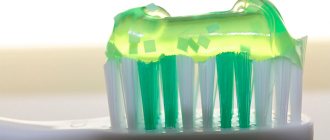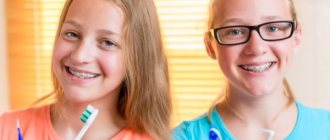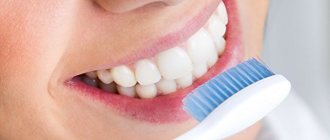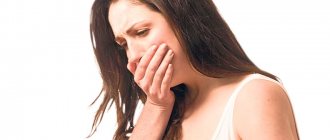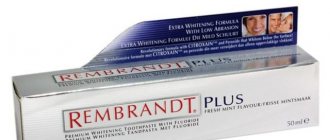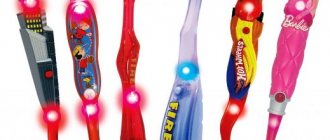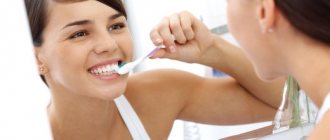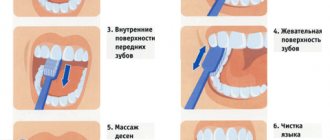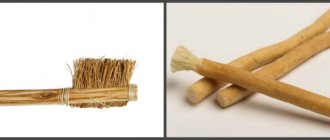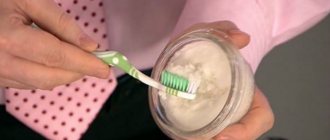The benefits of brushing your teeth with an electric brush
Electric brushes are more effective at cleaning teeth from plaque and food debris . This device is as easy to use as possible; it is perfect for children and people with disabilities .
Brushing your teeth with an electric brush requires much less toothpaste than manual brushing. With this product it is easier to achieve the teeth whitening effect.
For your information! The versatility of the device lies in the fact that the whole family can use it.
just need to buy an individual nozzle for each family member . Children really like these brushes; the process of maintaining oral hygiene turns into a game. However, it is important that an adult monitors how the child brushes his teeth .
Using
special sensors, the pressure force is controlled . Due to this technology, the risk of abrasion of enamel and injury to the gums is minimized .
Many models have a timer that counts the time needed for proper teeth cleaning.
Electric toothbrushes are more environmentally friendly. Making one regular brush takes the same amount of plastic as 14-42 replacement brush heads.
Electric brush care
The beauty of electric toothbrushes is that they are not only effective in their own right, but they are also smart. Many devices have pressure sensors that prevent you from pressing the brush too hard against your teeth—if you press too hard, the brush will beep or vibrate, warning you to release the pressure.
There are also timers that are especially good for children who are just getting used to personal hygiene - 2-3 minutes after turning on the brush will notify you that it is time to finish the procedure. There are different modes of operation depending on the model: delicate cleaning, massage, whitening, habituation mode, musical accompaniment in children's models.
But the most important thing is that electric brushes have different attachments. For example, it is almost impossible to clean braces well with a regular manual brush. And an electric one with a special attachment copes with this task easily. You can also find attachments of varying hardness, attachments for whitening, and separate attachments for implants. In general, care can be truly individual and convenient.
In general, you need to care for an electric toothbrush in the same way as a regular one. The processing rules are not too different. The pocket with batteries and microcircuit is reliably protected from moisture, so the device can be washed without fear.
However, there are several important nuances that need to be taken into account when caring for an electric brush:
- The bristle head wears out within 3 months and must be replaced.
- Discharged batteries should never be left in the device. They may start to leak. Then not only will the brush be damaged, but the acid may get into your mouth and cause poisoning.
- After use, the electric brush should be rinsed with warm water and dried.
Every day, billions of bacteria come into contact with your toothbrush from your mouth. Among them are streptococci, staphylococci, E. coli, porphyromonas gingivalis, herpes and hepatitis viruses A, B, C, candida albicans, coliform and many others. Improper care can lead to frequent illnesses. It is important to thoroughly wash and dry the bristles, choose a suitable place to store brushes, and observe personal hygiene rules. Every 3 months the device must be replaced.
After each brushing of your teeth, you need to take care of your brush and brush head. Rinse the head under running water with the handle turned on for several seconds, and also rinse the nozzle separately, removing it from the body. All parts must be dried and wiped dry before assembly.
We suggest you read: Should you boil your toothbrush?
Indications for use
Anyone can use an electric toothbrush, even those with completely healthy teeth. Indications for use :
- presence of braces;
- periodontal diseases;
- the presence of dentures and crowns in the oral cavity.
Attention! Although almost anyone can use such a device, you should consult with a specialist before purchasing it. Due to some individual characteristics, the use of such a device may be contraindicated.
How to choose?
When buying an electric toothbrush, you need to pay attention to a number of nuances.
First of all, the dynamics of the movement of the nozzle is assessed . The device will only be effective if the nozzle rotates and vibrates at the same time.
Please pay attention to the following aspects:
- good battery;
- presence of a timer for brushing teeth;
- the presence of replaceable nozzles.
It is important that the device has a high-quality battery : large capacity and light weight. If it is too heavy, it will create some discomfort when using the brush. The product must be light .
It should be noted! A teeth brushing timer is needed for better cleaning.
It can be general - 2 minutes, and such that it gives a signal every 30 seconds, indicating the need to change the exposure zone.
Modern models allow the use of several types of replaceable nozzles .
The main thing is that they can be easily purchased. Otherwise, the device will become completely useless.
There are several types of such a device:
- classic;
- sound;
- ultrasonic
The classic electric brush is distinguished by the fact that it allows you to make reciprocating movements in a circle and pulsating from top to bottom . The set may include several attachments at once: for cleaning, polishing teeth and massaging gums.
The sonic brush operates using a high frequency generator . It converts electricity into sound vibration waves. Such a device not only removes plaque and food debris, but also, due to sound vibrations, weakens the attachment of microbes to the teeth.
The operating principle
ultrasonic brush is to convert electricity into ultrasonic waves.
Ultrasound allows not only to destroy the attachment of microorganisms to teeth, but also to remove pigment plaque from the enamel .
The choice of a specific model (Oral-B, Philips, Hapica, etc.) depends on individual preferences and the purchase budget.
Cleaning the Exterior
The use of an electric brush requires systematic care of it.
- The attachments are washed under warm running water.
- Disinfectors and sterilizers are used if they are provided by the manufacturer.
- Cleaning work is carried out to destroy pathogenic microorganisms and paste residues.
- The clean nozzle is placed back on the device.
- The product dries in a vertical position.
The head of the device is not covered with anything; there must be access to air. The nozzles are replaced as they wear out. Typically, they last from 90 to 180 days.
If there are no dental problems, make an appointment with the dentist once every 6 months. If you have oral problems, visit the dentist more often.
This is the first step of instructions on how to use an electric toothbrush. You can start with the upper jaw, or you can start with the lower jaw. It's not that important. The cleaning head of the brush should be moved slowly from one tooth to another, pausing for 1-2 seconds on each one.
No movements should be made as the brush head is programmed with the desired rotation method. The brush should be held at a 45 degree angle.
One of those misconceptions that really irritates you. By expressing such an opinion, the patient seems to show his awareness and knowledge, but in fact remains an amateur, and amateurism in matters of health is not only dangerous for the patient himself, but also threatens you with unnecessary complications in your work.
In fact, over 250 clinical studies have proven that brushes with reciprocating technology and a round brush head remove up to 5 times more plaque from under the gum line. They brush their teeth exactly as recommended by the world's leading dentists.
We suggest you read: How often can you use an electric toothbrush?
You can learn more about electric toothbrushes and understand why many of your colleagues really recommend them to their patients on the website of the Oral-B and Blend-a-med Institute
The Braun Oral-B Vitality Cross Action D12.513 electric toothbrush can hardly be called bulky. It fits perfectly in the hand, is absolutely not heavy and can easily fit even in a compact women's handbag. The only thing is that the package does not include any travel case or cover; such an accessory must be purchased separately.
This brush was entrusted and handed over to my wife for testing; she had never had to use this kind of device before, so her opinion was important to me.
The difference compared to regular toothbrushes is colossal! The first two to three days of using the Braun Oral-B Vitality Cross Action D12.513 toothbrush caused discomfort. It was necessary to get used to the vibration, and also learn to regulate the pressure so as not to damage the gums or cause bleeding.
It is best to consult a dentist before using an electric toothbrush, as some people may have contraindications: gum sensitivity, braces, etc.
Compared to a regular toothbrush, an electric toothbrush does an excellent job of removing plaque, food debris between teeth, and cleaning hard-to-reach areas.
It is always worth remembering that the toothbrush must be turned on after it has been brought to the teeth, otherwise there is a chance of doing a thorough cleaning in the bathroom. Compared to a regular toothbrush, an electric toothbrush requires a minimal amount of toothpaste for cleaning, thus saving a small amount. It's a small thing, but it's nice!
As mentioned above, an electric brush is much more diligent than a regular one and penetrates where a standard one does not reach. There are three types of electric brushes: rotary, sonic and ultrasonic. In the first, the cleaning head moves back and forth at a frequency of up to 18,000 revolutions per minute, sometimes spinning around its axis.
Sound ones have much higher revolutions (up to 60,000) - due to the sound generator, they make so many vibrations per minute that they are practically not felt. Ultrasonic, as the name implies, works using ultrasound and, in addition to cleaning, also disinfects the oral cavity.
All three types will be many times more effective than a standard brush. Sonic and ultrasonic can clean teeth from dense dirt, efficiently clean hard-to-reach places and deep interdental spaces. At the same time, you will not need to vigorously rub your teeth or press on the brush - the devices work very delicately even with damaged or thin enamel.
After external cleansing, the teeth must be cleaned from the inside. The process here is the same - you need to move slowly from tooth to tooth. To clean the inside of the front teeth, turn the brush vertically. When performing the procedure, it is important to ensure that the device treats all teeth.
After the procedure, you need to wash the nozzle with warm water. Many companies that produce such products produce sterilizers and disinfectors for this device, which are used for complete cleaning and elimination of bacteria.
Nozzles must be changed when they wear out. Typically, the duration of operation of one can be 3-6 months. After replacing the attachment, the device can be used as before.
How to choose pasta?
It is best to use the toothpaste recommended by your doctor. People with healthy teeth can use universal hygienic toothpastes . They have an antiseptic effect, whiten and freshen breath.
For the purpose of prevention, sometimes it is necessary to switch to pastes to prevent caries and periodontal lesions . They contain fluorine and calcium compounds.
Important! You need to be as careful as possible with whitening pastes, since they contain chemical oxidizing agents or abrasive particles.
Such products are contraindicated for those who have increased enamel sensitivity.
Children are advised to use low fluoride toothpastes . In the period from 6 to 13 years, it is necessary to give preference to products with a minimal amount of abrasive substances and a high calcium content. Upon reaching 13 years of age, you can switch to adult pastes.
Contraindications
Almost all contraindications to using an electric brush are relative or temporary. The use of the device should be discontinued in the following clinical situations :
- after surgery in the dentofacial area;
- stomatitis;
- tooth mobility grade 3;
- after oncological surgery;
- hypertrophic gingivitis.
Note! Only after eliminating such pathologies or abnormalities can you begin to use an electric device for brushing your teeth.
If you experience unpleasant sensations while using the brush, it is better to abandon them completely.
How to properly brush your teeth with an electric toothbrush?
Proper brushing of your teeth with an electric toothbrush should be done in several stages.
Initially, you need to check whether the device is charged and recharge if necessary.
The algorithm for cleansing the oral cavity using an electrical device is as follows:
- A small amount of toothpaste is applied to the nozzle. You should not squeeze out a lot of product , as due to excessive foaming, the procedure will need to be completed ahead of time.
- Brushing begins with the top row of teeth . It is recommended to stay on each tooth for 3-4 seconds. The entire oral cavity is conventionally divided into 4 zones: upper, lower, left and right. Movements should be circular . It is necessary to clean your teeth not only from the outside, but also from the inside.
- The tongue must be cleaned as carefully as possible . This way you can get rid of bad breath.
- After finishing cleaning, you must rinse your mouth thoroughly and rinse the nozzle .
It should be noted! It is important to wash the nozzle and change it periodically. The optimal interval is once every 3 months. When the bristles become deformed, the attachment is changed more often.
PACKING AND EQUIPMENT
The equipment package of the Braun 9000 cannot be called meager. In addition to the brush itself, the set includes a box for storing four different attachments and the attachments themselves, a standard charger, a bracket with a suction cup for attaching a smartphone to the mirror, and a transport box with its own charger.
The attachments differ in purpose: advanced and gentle are used for cleaning, Oral-B FlossAction removes plaque between teeth, and Oral-B 3D White is best suited for whitening.
The transport box holds a brush and 2 attachments and, when opened, serves as a stand for a smartphone. When you connect the charger, the accessory can be used to recharge your smartphone - an additional USB connector is provided for this.
Holes on the side of the case provide air circulation: a wet brush will dry quickly and will not dry out. The container itself is easy to clean: traces of toothpaste, which may appear on the surface over time, can be easily wiped off with a damp cloth.
Compared to other accessories, the travel box looks quite large, although in fact it is only slightly larger than a standard can of shaving gel.
The smartphone holder can be attached to any surface – for example, on a bathroom mirror. Correct positioning of the smartphone on the mirror is required for the cleaning control mode to work correctly. But more on that below.
The Braun Oral-B Vitality Cross Action D12.513 electric toothbrush is supplied in a transparent protective plastic blister, the lower part of which is placed in a cardboard insert. The printing is of high quality, despite the small size of the insert it is quite informative. There was also hidden advertising for the World Cup =).
By tilting the insert to the side, you can view the entire toothbrush from three sides. To open the package you need to use something sharp - scissors and a stationery knife.
- Electric Toothbrush;
– one nozzle;
– charging base;
– documentation.
Mistakes when brushing your teeth
The first and most common mistake is the wrong choice of nozzle and paste . They should be selected depending on the condition of the gums and tooth enamel.
Brushing your teeth quickly or infrequently will be ineffective.
If a lot of time passes between cleansing procedures, then a large amount of plaque appears on the teeth. This, in turn, leads to the development of the inflammatory process.
It is also a mistake to clean too often . It is dangerous due to irritation of the gums and thinning of tooth enamel. Incorrect teeth cleaning technique will negatively affect their condition.
The use of a dirty nozzle leads to the growth of bacteria. After each use, it must be rinsed thoroughly, as some plaque may remain on the bristles.
Important! Infrequent replacement of nozzles negatively affects the quality of cleaning.
It is recommended to change them every 3 months , if possible this can be done more often. During use, the bristles lose their flexibility and become deformed. In a shared bathroom, it is recommended to store brush heads in special cases . This is because flushing the toilet spreads bacteria that can settle on the brush.
Disinfect your toothbrush
This must be done once a week. Dip it for 10-15 minutes in a glass with antibacterial rinse or other disinfectant that is suitable for such accessories. After this, you need to dry the bristles. Today, special sterilizers for brushes are produced that operate on the basis of ultraviolet rays. But you will have to spend money on such a device.
